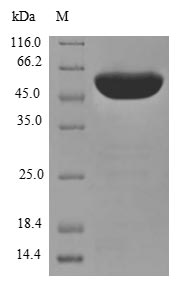The expression region of this recombinant Human PDIA3 covers amino acids 25-505. The theoretical molecular weight of the PDIA3 protein is 59.3 kDa. This protein is generated in a e.coli-based system. The PDIA3 coding gene included the N-terminal 10xHis tag and C-terminal Myc tag, which simplifies the detection and purification processes of the recombinant PDIA3 protein in following stages of expression and purification.
Protein disulfide-isomerase A3 (PDIA3), also known as endoplasmic reticulum protein 57 (ERp57), is a member of the protein disulfide-isomerase (PDI) family. PDIA3 plays a crucial role in protein folding and quality control within the endoplasmic reticulum (ER), where it aids in the formation and rearrangement of disulfide bonds in newly synthesized proteins. As a thiol-disulfide oxidoreductase, PDIA3 contributes to the correct folding of glycoproteins and helps maintain ER homeostasis. It interacts with major histocompatibility complex class I (MHC-I) molecules, facilitating their assembly and transport to the cell surface for antigen presentation. PDIA3 is also involved in various cellular processes, including regulation of apoptosis and modulation of cell signaling pathways. Research on PDIA3 encompasses its roles in protein folding, ER stress response, immune system function, and its implications in diseases such as cancer and neurodegenerative disorders.






